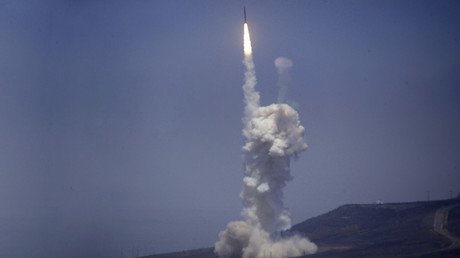NATO’s increased military presence in E. Europe doesn’t mean return to Cold War – Stoltenberg

NATO will continue increasing its presence in Eastern Europe as Russia remains a serious security challenge for the block, NATO Secretary General Jens Stoltenberg said as he presented his annual report.
“We have already increased our presence in the East (of Europe), with the assurance measures; with more planes in the air; with more boots on the ground; with more ships in the Baltic Sea and the Black Sea… we’ve been also establishing this small headquarters and we have more exercises taking place in the East,” Stoltenberg said in Brussels on Thursday.
The measures he mentioned have “already been decided and have already been implemented” by the block in Poland, Ukraine, the Baltic States, and elsewhere, he added.
However, Secretary General stressed that this didn’t mean a return to “the Cold War posture with hundreds of thousands of troops based along the borders.”
“There’s no way we’ll move back to that posture. But we are talking about some increase in military presence and increase in the ability… of our forces to deploy,” Stoltenberg explained.
The NATO Summit to be held in Warsaw, Poland this summer will be aimed at finding “the right balance” between the two trends, he added.
According to the NATO chief, the block is urging its members to increase its military spending due to “the changed and more challenging security environment,” noting that “Russia is of course a part of that.”
“Russia, which has invested heavily into defense over several years, which has also shown the will to use military forces to change borders in Europe. And this is the first time this has happened since the end of World War II,” he explained.
The Secretary General was apparently talking about Russia’s reunion with the Republic of Crimea that took place in March of 2014 after a referendum confirming overwhelming support for the move from the Crimean population.
He also blamed Moscow for “continued military actions in Ukraine and its recent military buildup in Syria and eastern Mediterranean.”
Stoltenberg said that the block is currently considering the possibility of holding a NATO-Russia Council meeting as “more transparency, more predictability” is needed in order to strengthen the mechanisms of communication while carrying out military operations in Syria.
“We have never suspended the Council, but we think that at the same time now it’s time to look into the possibility of having a meeting. No final decision has been taken, but we will also discuss this with the Russian delegation in NATO and then make a final decision on when we should have such a meeting,” he said.
READ MORE: Poland could soon be home to ‘more NATO ... than ever’, Stoltenberg says
Stoltenberg also claimed that Russia is “spending a lot on… different kinds of propaganda,” but stressed that NATO “will not counter propaganda with propaganda.”
“We have to stay vigilant; we have to be ready to answer and to provide the truth – facts, figures… because in the long run we’re certain that the truth will prevail,” he said.
The NATO chief also talked about the execution of the Minsk peace agreement between the Ukrainian government in Kiev and the rebels in the country’s east, describing the picture as “mixed” and “fragile” due to violations still being committed by both sides.
Stoltenberg also commented on a US request to NATO to provide surveillance planes to aid in the battle against Islamic State (IS, formerly ISIS/ISIL) in Syria and Iraq.
“We have got a request from the US to provide support to the efforts of the coalition, to help them with the NATO AWACS (Airborne Warning and Control System) surveillance planes, and we are now looking into that request,” he said.
The block’s defense ministers will discuss the American request at a meeting in early February, he said.
NATO has already announced that it has deployed AWACS to Turkey to strengthen the country’s air defenses on the Syrian border.
However, Stoltenberg made no comment on the possibility of those planes playing a dual role in connection with the US request.
READ MORE: Unfounded claims? NATO ‘categorically rejects’ it threatens Russia
NATO isn’t directly involved in combating terrorists in Syria and Iraq, the Secretary General stressed, despite the fact that all of the block’s 28-members are part of the US-led coalition.














